Dashpivot article – Site Visit Report format


Site Visit Report format
What needs to be in your site visit report.
A site visit report is a comprehensive document that captures the details, observations, and the progress of a particular site at a specific point in time. This is often used by project managers, engineers, architects, and other professionals to document site conditions, progress, or any issues that might arise. The exact details can vary based on the purpose of the visit and the industry, but generally, the following elements are included in a site visit report:
- Project name
- Site address
- Date of visit
- Name of the people visiting
- Brief description of the project
- Purpose of the site visit
- Schedule and timeline of the site visit
- Persons met and their designations
- Discussions held or activities observed
- Detailed account of what was observed
- Photos (with captions or descriptions) can be particularly helpful
- Status of ongoing work
- Equipment/material present on site
- Safety measures in place and any violations observed
- Environmental considerations and their adherence
- Any deviations from the planned work
- Delays or challenges faced
- Areas of concern related to quality, safety, environment, or other pertinent topics
- Steps or measures suggested to address the identified issues or concerns
- Any follow-up required with specific persons or entities
- Overall assessment of the site visit
- Next steps or future visits
- Any additional documents, drawings, or references that can support the report content
- Maps or layouts of the site
- Signature of the people who visited the site to authenticate the report
- Date of signing
What should be your site visit report format?
Here's a sample format for your next Site Visit Report.
Report Title: Site Visit Report Project Name: [Project's Name] Location of Site: [Site's Address] Date of Visit: [Date, e.g., September 13, 2023] Report Prepared By: [Your Name/Team's Name]
1. Introduction: A brief description of the site and the project. Mention any background information pertinent to the visit.
2. Objective of Visit: State the main reason or reasons for the site visit.
3. Attendees: List the names and roles of all individuals present during the site visit.
4. Summary of Activities/Observations: Provide a brief overview of the day's activities, meetings, inspections, etc.
5. Detailed Observations: Document in-depth observations. This could include:
- Progress of the project.
- Work quality.
- Safety measures in place.
- Status of equipment/material on site.
- Interaction with site personnel.
6. Photos and Diagrams: Insert relevant photos and diagrams with captions. Ensure photos are clear and provide value to the report.
7. Issues/Concerns Identified: List any problems, concerns, or deviations observed during the site visit.
8. Recommendations: Based on your observations and identified issues, provide actionable recommendations.
9. Conclusion: Summarize the main findings from the visit and the overall status of the site/project.
10. Next Steps/Follow-Up: Detail the future actions required, potential follow-up visits, or any impending decisions based on the site visit.
11. Attachments: Mention any additional documents, notes, or materials attached to the report.
12. Signatures: Space for the report preparer and any required authorities to sign, indicating validation of the report's content.
See an example site visit report below to see the format in action.
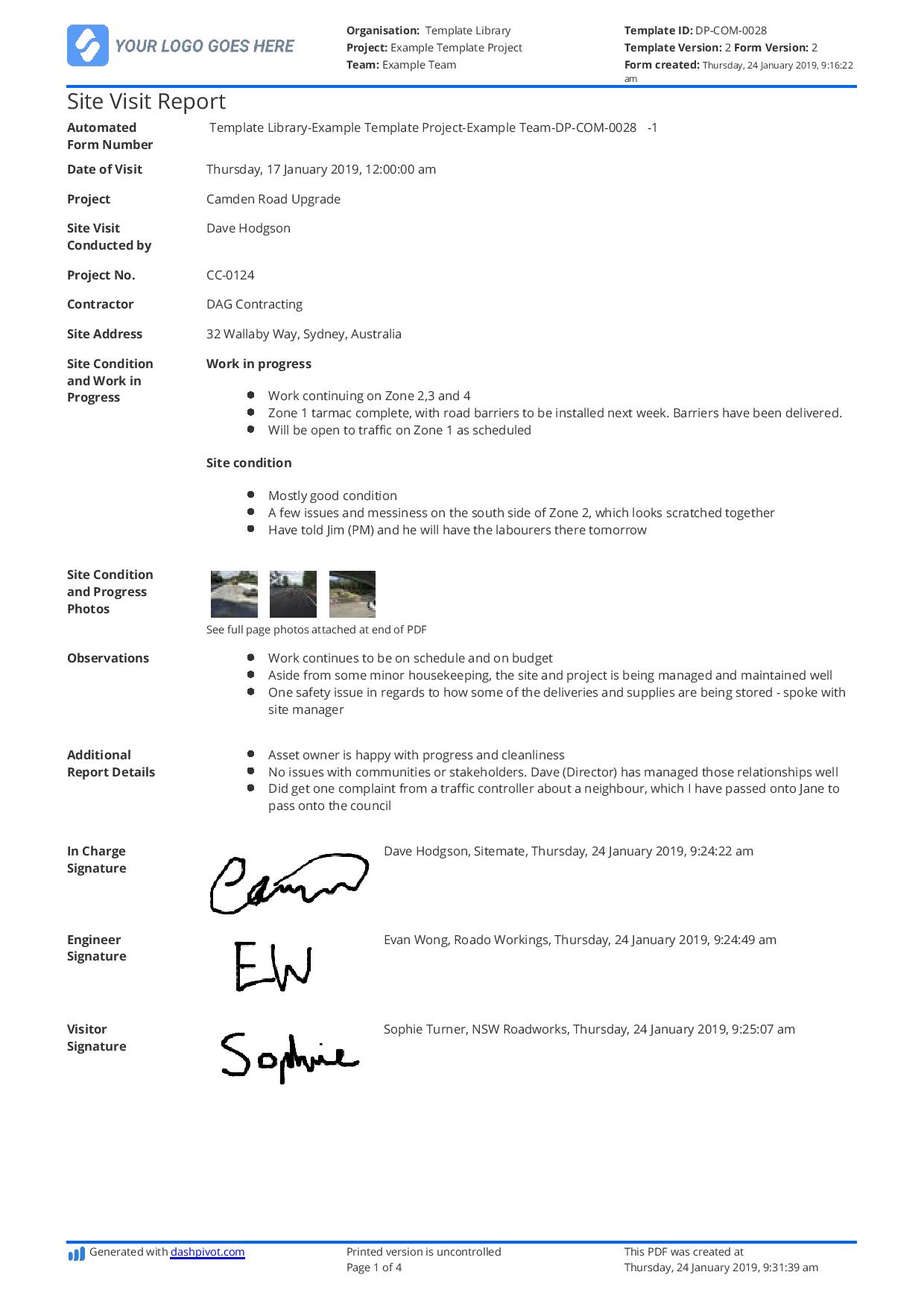
Use this free Site Visit Report format in a digital template
Standardise your site visit report format.
Keep your team running site visit reports in the correct format by using a digital site visit report template .
The free template comes pre-built with the format above, with all the fields, section and information for your team to carry out detailed site visit reports.
Customise the template with any extra information you need captured from your site visit reports, or a custom format, with the drag and drop form builder.
Distribute your digital site visit report for your team to fill out on mobile or tablet so they can fill it out on site while the information is still fresh and at hand.
Build processes for site visit reports
Create digital processes for your site visit reports to ensure the format is followed, reports are recorded on time and as scheduled and shared and accessible to the right people once they're completed.
Use a site visit report app to build fully automated site visit report workflows to request, plan, record and sign off on site visit reports so they meet the format and requirements you need.
Get analytics on site visit report performance and progress using the Analytics Dashboard, with breakdowns how different locations, projects and teams are performing.
Share completed site visit reports in a professional format as PDF or CSV to your team or third parties via the app.

Site diary template
Complete and organise your daily diaries more efficiently.

Meeting Minutes template
Capture, record and organise those meeting minutes.

Progress Claim template
Streamline and automate the progress claim process to get paid faster and look more professional.
Sitemate builds best in class tools for built world companies.
About Nick Chernih
Nick is the Senior Marketing Manager at Sitemate. He wants more people in the Built World to see the potential of doing things a different way - just because things are done one way doesn't mean it's the best way for you.
Leave a Comment Cancel Reply
Save my name, email, and website in this browser for the next time I comment.

Free Site Analysis Checklist
Every design project begins with site analysis … start it with confidence for free!
Site Visit Analysis and Report: How to conduct and evaluate your first architecture site visit
- Updated: January 2, 2024

Here we will cover everything you need to know about of how to approach your first site visit analysis for a new project, what to do when physically there, and how to eventuate and summarize the information you collect.
However before visiting for the first time we highly recommend that you carry out desktop study beforehand, as this will provide an important initial understanding of the site and generate far better results and more refined questions once there.
The desktop study will also help to identify the important items of equipment that you will need to take with you to make your trip as successful as possible. …these are mentioned below but may include a:
- Site map (very important)
- Tape measure
- Laser distance meter
…more essential architects items here

Conducting an architecture site visit analysis
A site visit analysis is a comprehensive report that summarizes the findings of a physical inspection of a potential development site. It includes information on the site’s physical characteristics, location, surrounding area, demographic information, environmental impact, zoning regulations, traffic flow, and recommendations for development.
The report synthesizes all gathered information to provide a comprehensive understanding of the site and its potential.
What to look for?
Once there, there are a whole number of important areas and items that need to be studied and recorded, some of which would have already been identified during your desktop study, but as a starting point we’ve produced the below list of all the key areas:
We suggest that you take these with you and tick them off as they are found, so not to miss anything.
- Entrance and access points (both pedestrian and vehicle)
- Security (gates, surveillance)
- Travelling to the site (road types and suitability, safety, public transport)
- Boundary treatment (fencing, vegetation, land form, water)
- Extent of boundary (does it match the survey/OS map)
- Circulation (existing travel routes within the site)
- Noise levels (quiet and loud areas)
- Services (electric, gas, water, sewage)
- Existing buildings (condition? Relevant? Protected?)
- Existing landscape features (condition? Relevant? Protected?)
- Neighbouring buildings (local vernacular, protected?)
- Views in and out of the site (areas to screen off and areas to draw attention to)
- Tree’s and vegetation (protected and rare species)
- Ecology (any areas likely to be home to protected species)
- Orientation (sun and wind paths)
- Light levels (areas in direct sunlight, shaded areas, dappled light)
- Accessibility (disability access)
- Surrounding context (historical, heritage, conservation area, SSSI, AONB)
- Existing materials in and around the site
- Topography (site levels)
- Flood level (is it likely to flood)
- Soil and ground conditions (types and suitability)
- Existing legal agreements (where are the rights of way, covenants)
- Hazards (Electricity lines, Drainage, Telephone lines, Sub-stations)
We provide a site analysis checklist here covering all of the above that’s free to download.

Where to start
You want to begin documenting your visit as soon as you arrive, as the approach and entrance to your site are just as important as the site itself. If you’re desktop study didn’t highlight the possible routes and methods of transport to and from the site, then this needs to be recorded also.
Documenting your first impressions is vitally important, ask yourself; what do you see as you enter the site? what do you hear? what do you feel? (…what senses are the first to be triggered), you will only get one chance to do this properly and so you need to make it count!
…and don’t forget to include the location of the elements you record, when noting it down on your site map or survey. By the end of your visit, you should barley be able to read whats under all your notes …write down everything!
Moving on from first impressions, you should plan to walk around the site as least twice (as a minimum) to ensure that nothing is missed, so leave enough time to make a least two loops, noting down and photographing everything that you feel is relevant, no matter how small.
…there’s nothing worse than getting back to the studio and realizing you forgot to document something.
We like to use the check list supplied above and:
- Firstly walk around the site whilst annotating a site plan
- Secondly with a camera …photographing everything
- and thirdly with both …just in case something has been missed
This way we can focus on one task at a time, helping to ensure we gather everything we need.
In terms of a camera, and depending on your budget we suggest looking one these three options (but a phone is just as good):
- Sony DSCW800 Digital Compact Camera
- Sony DSCWX350 Digital Compact Camera
- Canon EOS 1300D DSLR Camera
It can be difficult to identify certain elements, and some may only be noticeable from a professional survey, such as underground services and precise spot levels. But approximations of such locations and heights are a good start and can serve as a reminder for further investigation.
If accessible you can of course take your own measurements and so this is where a tape measure and/or distance meter will come in handy.
Try one of these:
– Tape measure
– Laser distance meter
What to take with you
Firstly look at the weather, you wont have a good time if your not dressed appropriately, and this applies to protecting your notes and equipment as well as yourself.
…a simple quick check, can make or break a visit, arranging to go on sunny day will also give you the best site photographs, which could also be used in future CGI’s and presentation material.
If the site is derelict, or has potentially dangerous or hazardous elements, it is likely that you will require personal protection equipment (otherwise known as PPE) so make sure this is organised before setting off.
As a minimum you want to take with you a camera, a pen and an OS map. Google Maps can provide a temporary (though very basic) version, but a much preferred scaled version that can normally be obtained through your university or practice via such companies as:
- Digimap – digimap.edina.ac.uk
- Xero CAD – xerocad.co.uk
- CAD Mapper – cadm a pper.com (free account available)
As mentioned, you will want to make notes, and record everything you observe, experience and hear all over this map. So print out a couple of copies at a usable and convenient size.

A camera is essential in documenting the site, and the pictures taken during your visit are likely to be used on a daily basis throughout your project. So once again make sure you document and record everything.
Pictures should be taken from all distances, close zoomed-in sections of materials and textures along with shots of the site from a distance to include the area as a whole and within its context.
Note pads are important for obvious reasons, we prefer an A5 sized pad, as this is much easier to carry and hold than an A4 one.
Tape measures can be useful, but we never go on a site visit without a distance meter.
…and lastly if you’re visiting on your own, don’t forget to tell someone where you’ll be and take your phone with a charged battery.
Our site visit equipment check list looks something like this:
- Weather check
- Print out our “what to look for” checklist
- Site map (at least 2 copies)
- PPE equipment
- Scale ruler
If you are interested in trying our architecture site analysis symbols for your own site analysis recordings and presentation, then head over to our shop ( Here ).
FAQ’s about site visit analysis
What is included in a site analysis.
As discussed above, site analysis typically includes the following elements:
- Site location and context: Understanding the location of the site in relation to the surrounding area, including climate, topography, neighboring buildings, and accessibility.
- Physical characteristics: Examining the site’s physical features, such as its size, shape, soil type, vegetation, and water sources.
- Utilities and infrastructure: Assessing the availability of utilities such as electricity, water, gas, and sewer, as well as the infrastructure, such as roads and transportation.
- Environmental considerations: Analyzing the site’s potential environmental impact and assessing any potential hazards, such as flooding or soil stability.
- Zoning and land-use regulations: Reviewing the local zoning and land-use regulations to determine the types of uses and development allowed on the site.
- Cultural and historical context: Examining the cultural and historical significance of the site and its surrounding area.
- Demographic information: Analyzing the demographic information of the surrounding area, including population, income, and age.
- Traffic and pedestrian flow: Studying the flow of vehicular and pedestrian traffic in the area to understand the impact on the site.
This information is used to inform the design of a building or development project, taking into account the unique characteristics and constraints of the site.
What are the steps of site analysis?
including the above, the steps involved in conducting a site analysis report typically include:
- Data Collection: Gather data and information about the site, including maps, aerial photos, zoning regulations, environmental reports, and other relevant documents.
- Site Observations: Conduct a site visit to observe and document the site’s physical and environmental conditions, such as topography, vegetation, water sources, and neighboring buildings.
- Context Analysis: Analyze the site’s location and context, including its surrounding area, access to transportation, and cultural and historical significance.
- Demographic Analysis: Study the demographic information of the surrounding area, including population, income, and age, to understand the potential market for the development project.
- Traffic and Pedestrian Flow Analysis: Study the flow of vehicular and pedestrian traffic in the area to understand the impact on the site.
- Synthesis: Synthesize the information gathered in the previous steps to develop a comprehensive understanding of the site and its potential.
- Recommendations: Based on the analysis, make recommendations for the development of the site, taking into account the unique characteristics and constraints of the site.
These steps help architects and planners to gain a deeper understanding of the site and to make informed decisions about the design and development of a building or project.
Every design project begins with site analysis … start it with confidence for free!.
Leave a Reply Cancel reply
You must be logged in to post a comment.
As seen on:

Unlock access to all our new and current products for life .
Providing a general introduction and overview into the subject, and life as a student and professional.
Study aid for both students and young architects, offering tutorials, tips, guides and resources.
Information and resources addressing the professional architectural environment and industry.
- Concept Design Skills
- Portfolio Creation
- Meet The Team
Where can we send the Checklist?
By entering your email address, you agree to receive emails from archisoup. We’ll respect your privacy, and you can unsubscribe anytime.
SIGN IN YOUR ACCOUNT TO HAVE ACCESS TO DIFFERENT FEATURES
Forgot your details, what is an environmental site assessment.

An Environmental Site Assessment can refer to either a Phase I Environmental Site Assessment (ESA or Report), a Phase II ESA or just the ‘site visit’ portion of a Phase I ESA. If you are looking for information on the entire process of a Phase I Environmental Report , click through the link to learn more. If you’re here to understand just what is done in the site visit portion of a Phase I ESA, you are in the right place.
More often, an environmental site assessment is the physical assessment of a property as part of a Phase I ESA. The purpose of the assessment is to obtain information indicating the likelihood of identifying recognized environmental conditions (or REC s) in connection with the property. A REC is defined as the presence or likely presence of any hazardous substances or petroleum products in, on, or at a property: (1) due to release to the environment; (2) under conditions indicative of a release to the environment; or (3) under conditions that pose a material threat of a future release to the environment.
Who Does Environmental Site Assessments?
The site assessment is typically completed by an environmental professional or EP (as defined by the Phase I ESA ASTM Standard). During the site assessment, the EP will visually and/or physically observe a property as well as the exterior and interior portions of all structures, if present, for evidence of environmental conditions. The site visit will also include assessing the adjoining and surrounding properties as well but from public right-of-ways.

During the assessment, the EP will look for evidence of environmental conditions associated with the presence, storage, or disposal of hazardous substances or petroleum products, evidence of storage tanks, odors, pools of liquid, drums, unidentified substances, PCBs, stains, corrosion, drains, and sumps, pits, ponds or lagoons, stained soil or pavement, stressed vegetation, solid waste, wastewater, wells, and septic systems.
The information gathered from the Site Assessment will be combined with other data collected as part of the Phase I ESA and summarized into a final report. This report is used by property owners, buyers and lenders of commercial real estate to fully understand the environmental risks associated with purchasing a commercial property .
A3 Environmental Consultants has a series of training videos regarding the finer points of a site visit for new employees and associates that you are free to watch on Youtube.
They can be seen here:
If you need an Environmental Site Assessment , research or testing done on your property or one you are interested in purchasing, give A3 Environmental Consultants a call. We’ll get your project done with the utmost in confidentiality, we’ll meet or exceed ASTM Standard E1527-13 on any sort of commercial or industrial property. Our Assessments meet the requirements of all lenders and government agencies such as the Small Business Administration (SBA), Housing and Urban Development (HUD) and the United States Department of Agriculture (USDA). A3 Environmental Consultants can be reached at (888) 405-1742 or by email at [email protected].
What you can read next

Wetland Permitting: Jurisdictional Determination Request

SRP Program Nightmares: When CRE Projects Go Bad
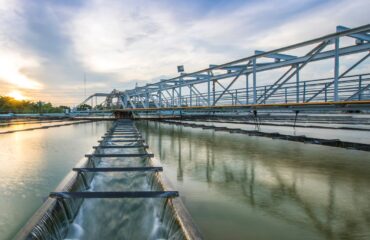
Best Environmental Engineering Companies In Chicago?

Call For A Consultation
RPF Environmental Recognized as Top Workplace Safety Services Company. CLICK HERE for Full Article
Home » Blog » Phase I ESA Process & Coverage: What is a Phase 1 Environmental Site Assessment?
Phase I ESA Process & Coverage: What is a Phase 1 Environmental Site Assessment?
Visit Our Video Center – Our Services – Markets & Industries
Table of Contents
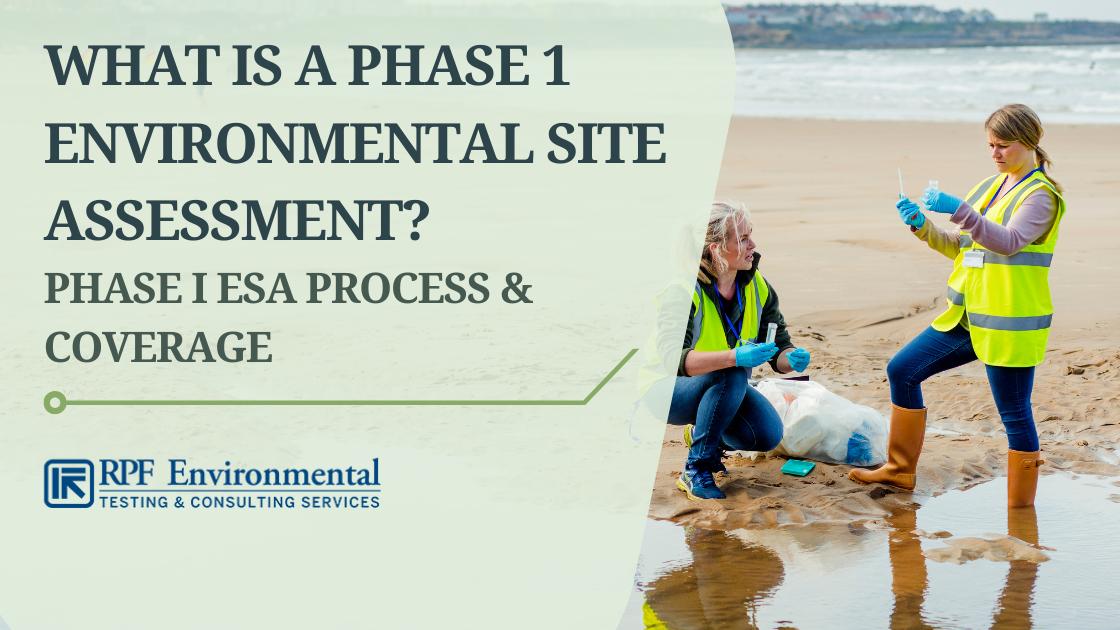
If you’re a property owner, purchaser, or lender and are here to understand Phase 1 Environmental Site Assessments (Phase 1 ESA) more, you’ve come to the right place! This blog will provide you with the important details you need to know about a Phase One ESA report including its scope, how and when it is done, how it will benefit your business, and more.
RPF Environmental offers professional Phase 1 environmental site assessments as well as certified Environmental Health & Safety (EH&S) training in New Hampshire, Maine, Massachusetts, and beyond. Contact us now!
Phase I Environmental Site Assessment: What is It?
There are three phases of environmental site assessments and Phase 1 is the introductory phase. It involves the identification of Recognized Environmental Conditions (RECs) . REC means the presence or potential presence of hazardous substances or petroleum products in, on, or at the property as defined by ASTM.
Phase I ESA is usually done before closing commercial or industrial real estate transactions . This is to evaluate the possibility of contamination and environmental risks that could affect the property’s value along with cleanup liabilities.
Who Conducts Phase I Environmental Site Assessments?
Only trained environmental professionals should perform a Phase I Environmental Site Assessment. ASTM standards , CERCLA’s (Comprehensive Environmental Response, Compensation, and Liability Act) All Appropriate Inquiry (AAI) rules, and other local requirements should be followed.
Expert environmental consultants, like RPF Environmental, are experienced in the required standards and regulations for Phase I ESA including ASTM and AAI. Thus, we can guarantee due diligence when it comes to environmental assessments.
ESA Phase I Coverage: What Does a Phase 1 Environmental Report Consist Of?
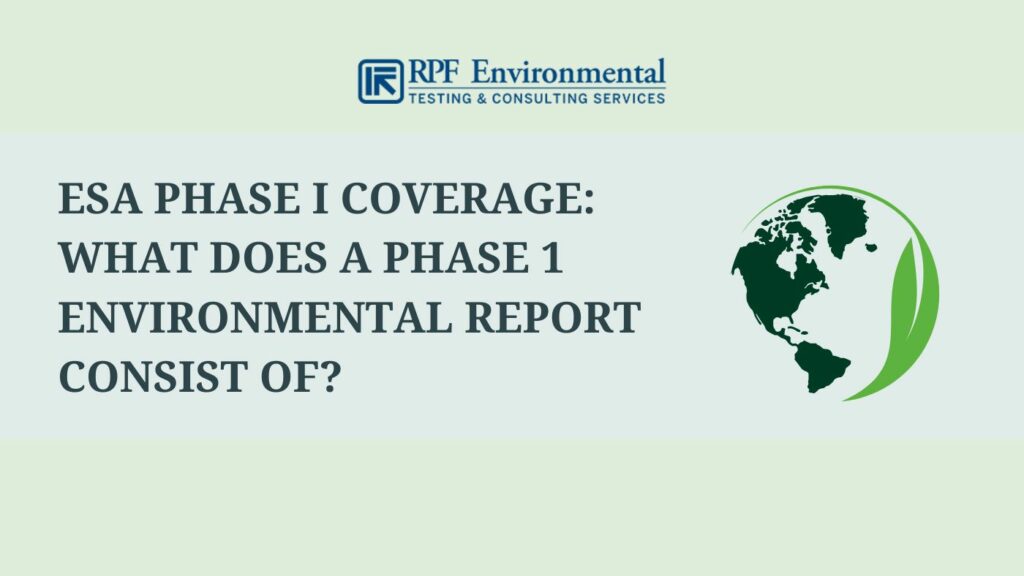
Phase I ESA reports aim to assess historical and current property uses including adjoining properties to determine the presence of potential threats to the environment or human health. This is done through the examination of historical records, interviews, and visual site inspection. (More on these later.)
However, take note that although ASTM has set standards for environmental assessments, other parties may have additional requirements like:
- The U.S. Department of Housing and Urban Development (HUD)
What Does Phase 1 Environmental Study Not Include?
Collection, evaluation, and other kinds of lab analysis for samples are not included in Phase 1 ESA such as:
- Soil and water testing
- Indoor Air Quality
- Radiological hazards
- Ecological resources
- Cultural and historical resources
- Endangered Species
Phase 1 Environmental Site Assessment Checklist: How is a Phase I ESA Done?
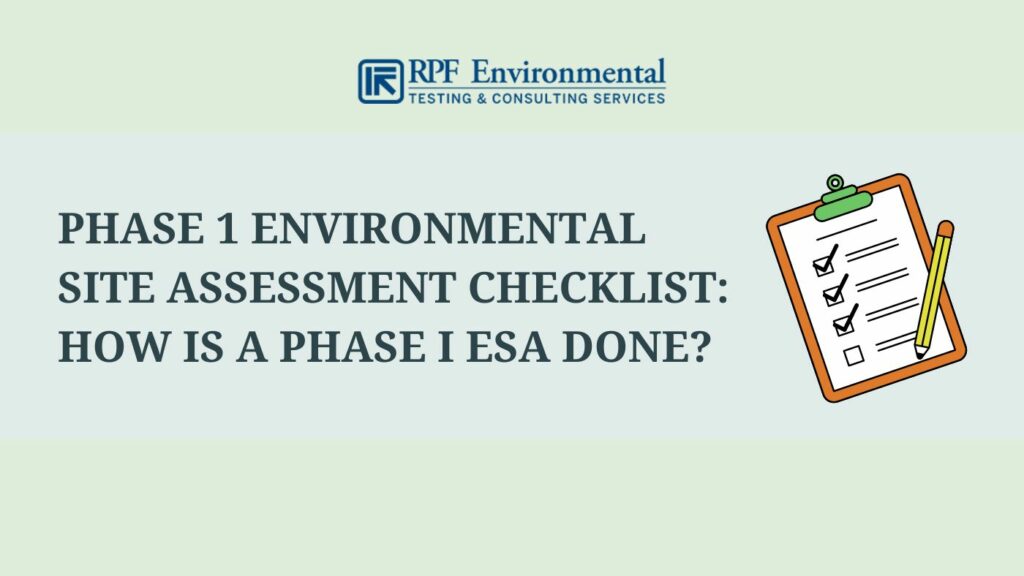
Phase 1 ESA consists of four major components:
1. Site Visit
Objective: To gather data that would suggest the presence of RECs through visual inspection of the site including adjacent properties that may be causing contamination.
This step includes the following:
- Inspecting the interior and exterior of the property including nearby properties
- Identifying storage containers and tanks
- Examining drainage systems, lagoons, ponds, and pits
- Evaluating the vegetation for possible signs of contamination
Site reconnaissance also involves observing past and current conditions as well as uses of the property and nearby ones . The environmental specialist may also take pictures and conduct measurements.
2. Review of Databases & Historical Records
Objective: To perform an extensive review of records and databases about the property to identify its current and previous uses that could result in contaminations.
This process includes reviewing:
- Federal, state, tribal, and local databases to identify aboveground storage tanks (ASTs), underground storage tanks (USTs), storage and disposal of hazardous substances (e.g. petroleum products), and others
- State and local agency records like environmental agencies and health, fire, and building departments
- Property tax files, building permits, and land titles to determine past business owners
- Geological surveys and maps (e.g. topographic, fire insurance, oil, and gas maps) to determine the site’s characteristics
- Historical uses through aerial photographs, historical city directories, land use records, and others
3. Interviews
Objective: To gather additional information by conducting interviews with organizations and individuals familiar with the site and surrounding properties.
Individuals who may be interviewed include:
- Health, fire, and water departments
- Current and past owners
- Property operators
- Local government officials
The last step would be to compile a report documenting the findings with conclusions and recommendations for further investigations in case RECs have been identified.
RPF Environmental has certified experts who can perform thorough and complete Phase 1 ESA. We provide tailored services to real estate professionals and other clients who are concerned about contamination and health risks that might affect their property. Book an appointment now!
Conducting Phase I Environmental Site Assessments: When, Where, and Who
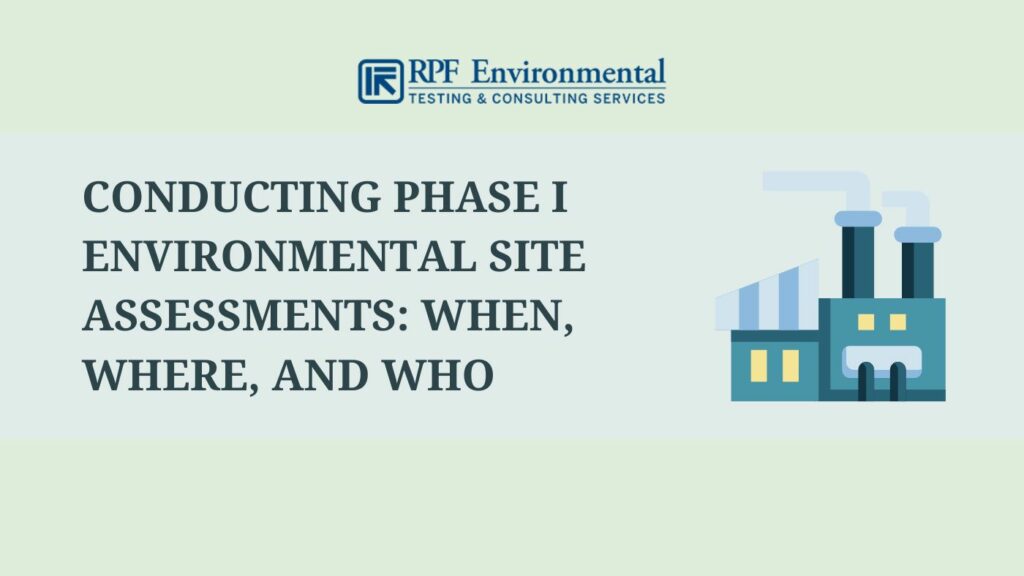
Phase 1 site assessments can be requested voluntarily by individuals who want to evaluate the environmental condition of a commercial or industrial property.
When Is a Phase I ESA Done?
Below are the common reasons why a Phase 1 ESA might be conducted:
- If the property has actual or is suspected to have hazardous substances due to past or current activities including those in surrounding properties
- If you are purchasing a property and want assurance about its condition
- To satisfy the requirements for the innocent landowner (ILO) defense
- When financing properties where banks or lenders would require a Phase 1 site assessment to get a more reliable property value
Where is a Phase 1 Site Assessment Conducted?
Phase 1 ESAs can be conducted on any type of property including:
- Industrial, commercial, and agricultural properties
- Multi-family residential properties
- Vacant land
- Gas stations
- Dry cleaners
- Auto repair shops
- Refineries, etc.
Who Needs a Phase One ESA?
Individuals who might benefit from a Phase 1 environmental site assessment include:
- Property owners and buyers
- Potential tenants
- Lenders and borrowers
- Property managers
- Contractors
Why Is ESA Phase 1 Important?
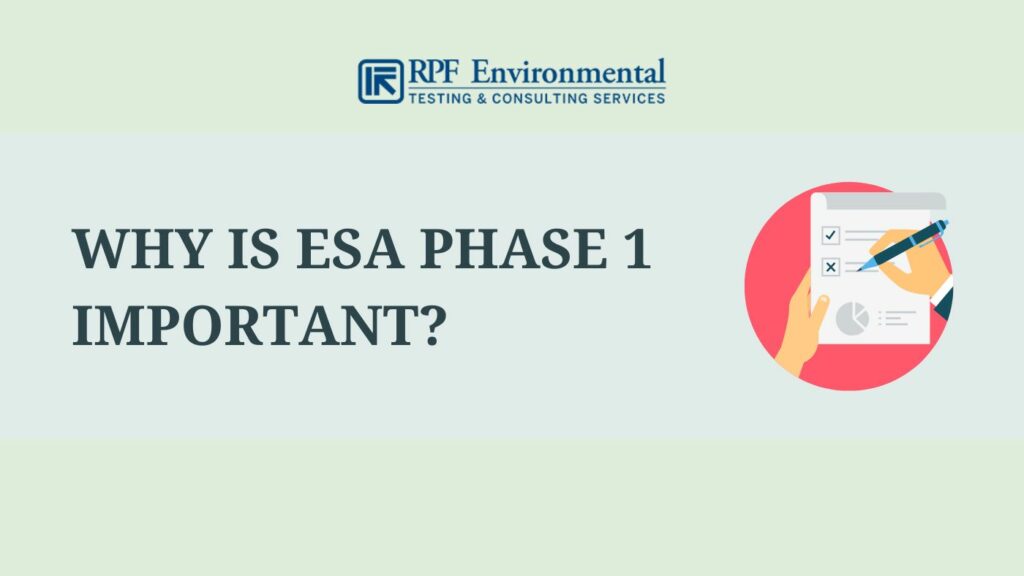
Federal and state regulations don’t require Phase I assessments. But if you want to save yourself from costly legal issues in the future, we recommend conducting it. Lenders and banks also usually require it for real estate transactions to protect loans.
Among the two most important reasons why you should perform a Phase 1 ESA are:
#1 To Protect Yourself from Future Liabilities
There are a lot of risks when you’re starting a business. These include dealing with hazardous contamination in your newly acquired property and liability problems regarding costly cleanups. Performing environmental site assessments before closing the deal helps in minimizing these risks and protects the lender or buyer from future liabilities.
In addition, you can only qualify for Landowner Liability Protections (LLPs) through a Phase I ESA by complying with the requirements for CERCLA’s AAI rule. LLPs protect landowners from responsibilities regarding specific injuries or damages on their property.
#2 To Protect Property Value
Phase 1 site assessments can identify RECs that could impact the condition of the site which could affect the value of the property. This is done by investigating past uses. For instance, high-risk applications such as gas stations and other industrial applications will significantly impact the environment of the property even years after the business was vacated.
What’s the Cost of Phase 1 Site Assessments?
This can considerably vary depending on various factors such as the location of the property and the complexity of its history. For instance, former industrial sites might be more expensive due to potential soil and water contamination from hazardous substances like lead and asbestos.
Reliable companies usually offer prices ranging from $1,500 to $6,000+ . If you are offered less than $1,500, you should be wary. Because if the specialist you hired fails to conduct a Phase 1 ESA properly, you might face more costly legal issues once other institutions have confirmed the presence of RECs.
How Long Does a Phase 1 Site Assessment Take?
Reviewing records and historical data as well as interviews may consume a lot of time, especially for properties with a complex history. But, Phase I ESA usually takes 2 to 4 weeks or more. This process requires sufficient time to ensure a reliable assessment.
What’s the Difference Between Phase 1 and Phase 2 ESA?
Phase 1 only assesses the possibility of contamination in the site through visual observation and reviewing regulatory records and historical use. On the other hand, Phase 2 involves soil and water sampling with scientific tests to assess the extent of the contamination. This also determines remediation needs for the elimination of the contamination.
Do I Need a Phase 1 ESA? Or Can I Skip Right to Phase 2?
No, you can’t perform a Phase II environmental site assessment without conducting a Phase 1 ESA. The results of Phase I ESA (i.e. RECs have been found in the property) will determine whether further investigations via Phase II ESA are needed.
What’s Next After Phase 1 ESA is Completed?
Depending on the findings in the Phase I assessment, the involved parties may choose to proceed with a more extensive investigation of the site via Phase II assessment. But a Phase 2 ESA must be done once the presence of RECs in the site has been confirmed. In addition, some lenders and agencies may also request additional compliance reports.
Also Read :
- What is EHS & Why is It Important?
- Safety Audits & Remediation: Everything You Need to Know about EHS Auditing
- Environmental Compliance Audits: What Are They & How Are They Conducted?
- Understanding the Basics of System Audits: Objectives, Process, & Importance
A Phase 1 ESA involves visual site inspection , review of databases and historical records , and interviews with individuals who might help in providing additional data. This is to identify RECs that might affect the property’s value.
The key objectives of a Phase I ESA are due diligence and protection against costly liabilities including cleanup. They are usually done for property financing purposes and to minimize risks of putting up a commercial business.
Phase I Environmental Site Assessments are important when buying or selling commercial and industrial properties. Aside from protecting landowners and other parties from costly legal issues, they also protect the value of the property to guarantee that you’re making the right investments.
RPF Environmental has certified experts to conduct Phase I environmental assessments as well as EH&S trainings . We provide professional environmental and testing services in Massachusetts, Maine, New Hampshire, and other New England areas. Contact us now!
- Categories: EHS
Related Posts

254 Commercial St Merrill’s Wharf, 2nd Floor Portland, ME 04101
Map & Directions
Massachusetts
205 River Street 2nd Floor, Unit 115 Haverhill, MA 01832
New Hampshire
320 1st New Hampshire Turnpike Northwood, NH 03261
10827 S. Western Avenue Chicago, IL 60643
1404 119th Street Whiting, IN 46394
Site Map Privacy Policy

404 Not found

- Phase I Environmental Site Assessment
- The Phase I Environmental Site Assessment Overview
- Baltimore, Maryland Phase I Environmental Site...
- Property Condition Assessment Reports
- Facility Condition Assessment
- Seismic Risk Assessments
- Structural Engineering
- Building Envelope Consulting
- Historic Architecture Solutions
- MEP Solutions
- Accessibility & ADA Surveys
- Forensic Engineering
- Building Technology Assessments
- Facility Management Plan
- Document & Cost Review
- Project & Budget Review
- Contractor Evaluation
- Construction Progress Monitoring
- Funds Control/Funds Disbursement
- Completion Commitment
- Construction Status Review
- Cost-to-Complete
- Owner’s Representative Services
- Surety Consulting
- ESG Consulting
- Climate Hazard & Property Resilience
- Building Efficiency Engineering
- Green Building Certifications
- Decarbonization Pathways
- Solar Consulting
- Renewable Energy Consulting
- EV Charging Consulting
- Affordable Housing & LIHTC Energy Services
- Multifamily Green Financing
- Phase II Environmental Site Assessment
- Remedial Cost Estimates
- Site Characterization
- Environmental Remediation
- Vapor Intrusion/Vapor Encroachment Assessments
- NEPA Assessment & Compliance
- Wetlands Services
- Environmental Compliance
- Industrial Hygiene
- Health & Safety Compliance
- Site Selection and Feasibility
- New Development & Additions
- Construction Inspections & Quality Testing
- Geologic Hazards Consulting
- Forensics & Expert Witness
- Zoning Reports
- ALTA/NSPS Land Title Surveys
- Boundary Surveys
- Flood Elevation Certificates
- Topographic Surveys
- Land Use Consulting
- Stormwater Management
- Feasibility Study & Due Diligence
- Utility Investigations & Permits
- Development Proforma Review
- Conceptual Plan Development
- Construction Phase Services
- Acquisitions
- Partner News
- Family of Companies
- Our ESG Commitment

April 9, 2018
What is a phase i environmental site assessment.
IDENTIFIES POTENTIAL OR EXISTING ENVIRONMENTAL CONTAMINATION LIABILITIES
**Standards for a Phase I ESA Report have been updated from E1527-13. Please visit our service page for more information.
A Phase I Environmental Site Assessment , commonly referred to as an ESA, or Phase I ESA, is completed to research the current and historical uses of a property as part of a commercial real estate transaction. The intent of the report is to assess if current or historical property uses have impacted the soil or groundwater beneath the property and could pose a threat to the environment and/or human health. If these issues are found, it presents a potential liability for the lender and/or owner, as well as affecting the value of the property. A Phase I ESA completed prior to the closure of a real estate transaction can be used to satisfy the requirements of CERCLA’s ( Comprehensive Environmental Response, Compensation and Liability Act ) innocent land owner defense under All Appropriate Inquiries (AAI).
Phase I Environmental Site Assessment reports can be completed on all types of properties including vacant land, agricultural, multi-family residential, commercial, and industrial uses; however, all Phase I ESA reports are completed to comply with ASTM E1527-13 (exceptions are made for properties comprised of large primarily undeveloped land, which can be researched under ASTM E2247-16).
A Phase I ESA typically includes the following:
- A site visit to observe current and past conditions and uses of the property and adjacent properties;
- A review of federal, state, tribal, and local regulatory databases including, but not limited to, underground storage tanks (USTs), aboveground storage tanks (ASTs), known or suspected release cases, the storage of hazardous substances and disposal of hazardous wastes including petroleum products, and institutional and engineering controls;
- A review of historical records, such as historical aerial photographs, fire insurance maps (Sanborn maps), historical city directories, and historical topographic maps;
- A review of state and local agency records, including but not limited to state environmental agencies, Building Departments, Fire Departments, and Health Departments.
- Interviews with current and past property owners, operators, and occupants, or others familiar with the property.
- Interviews with the Report User for title or judicial records for environmental liens and activity and use limitations (AULs); specialized knowledge or experience; actual knowledge; commonly known or reasonably ascertainable information; the reason for a significantly lower purchase price; and the reason for the preparation of the Phase I ESA. It is the Users responsibility to provide this information to qualify for the innocent landowner defense.
This research is evaluated by the Environmental Professional (EP) to identify potential environmental risks to the property, such as current or historic operations that are known or suspected to have used hazardous substances or petroleum products during onsite operations. Some very common uses of concern are dry cleaners, gas stations, auto/vehicle repair, printing operations, and manufacturing. In addition to potential soil and groundwater contamination, ASTM E1527-13 addresses the concerns associated with contamination in soil vapor and the potential for vapor migration to pose a threat to onsite and offsite tenants.
While not part of ASTM requirements, Phase I ESA reports typically includes a discussion of observed suspect asbestos-containing materials (ACM), potential lead-based paint (LBP), and mold growth, as well as the potential for lead in drinking water and radon . Sampling for these non-ASTM concerns is beyond the scope of a standard Phase I ESA but can be included upon request.
ASTM E1527-13 provides the guidelines for a Phase I ESA report to meet industry standard, but there are other factors to consider when ordering a report. Projects associated with Fannie Mae , Freddie Mac , U.S. Department of Housing and Urban Development (HUD), and the Small Business Association (SBA) each have their own report requirements. This is also true of other lending institutions.
Once a Phase I ESA is complete, the Environmental Professional will summarize what concerns were identified on the property and make recommendations about what actions, if any, are needed to address these concerns. A recognized environmental condition (REC) indicates known contamination or the potential for the subsurface to have been impacted by contamination (either from the subject property or possibly from an offsite source). A controlled recognized environmental condition (CREC) identifies that the property has been impacted by contamination which has been investigated and remediated; however, contamination remains and would require additional work if redeveloped. A historical recognized environmental condition (HREC) identifies a release that impacted the subject property, which has been investigated and remediated, meeting unrestricted use criteria.
Identifying a REC will often include a recommendation for a Phase II Environmental Site Assessment to collect soil, groundwater, and/or soil vapor samples from the subsurface to analyze for contamination.
Get in Touch

Jenny Redlin, REPA
+1 310-765-7243
[email protected]
Other Resources You Might Like

December 15, 2023
Partner Welcomes Dave Sawicki as the Environmental Solutions Regional Director – Central Region
Partner Engineering and Science, Inc. is thrilled to announce the addition of Dave Sawicki PG, CPG to our team as the Director for Environmental Solutions – Central Region. With over […]

October 06, 2023
What the EPA’s Proposed Lead Dust Limits Mean for CRE Owners
Under the EPA’s proposed regulations, any detectable amount of lead dust found while conducting an assessment will be considered ‘hazardous’ and will require remediation. By Carlton Gordon | Published on […]

Why the Impact of the New Lead Dust Limits Could Be Substantial
Under the EPA’s proposed regulations, any detectable amount of lead dust found while conducting an assessment will be considered ‘hazardous’ and will require remediation. By Carlton Gordon | October 06, […]
Let us be your Partner

Phase 1 ESA
A Phase 1 Environmental Site Assessment is a fundamental part of the real estate due diligence process and provides critical information about environmental liabilities associated with a property being purchased.
What Is A Phase 1 ESA?
A Phase I Environmental Site Assessment (Phase 1 ESA) is an investigation of a property’s current and historical use. The process views and investigates a property in regards to former use in order to determine if there is a potential for hazardous conditions that might be present on the property. Typically, a Phase 1 environmental study involves an on-site inspection by an environmental firm with detailed photography to document conditions.
Lenders require a Phase 1 Environmental Site Assessment for all properties that are greater than 4 units. 100% of the time, lenders will require a Phase 1 study for commercial properties. For multifamily properties – it can go either way. A Phase 1 ESA interviews with past and present building occupants, and with owners of neighboring properties are also conducted to validate past uses. A Phase 1 ESA does not involve any testing of things like paint, soil, or moisture, though a visual inspection may indicate the presence of hazardous materials.
Our firm offers complete, thorough, and expedited Phase 1 ESA and consulting that is uniquely tailored to real estate developers. Our Phase 1 studies are performed by certified environmental professionals (EP) who are predominantly looking for indications of hazardous materials or other signs of conditions that would impact the health and safety of the area due to contaminants or hazardous conditions. Our goal is to provide you with a simple process that keeps you involved & informed throughout the process. When looking at Phase 1 Environmental Site Assessment companies, you won’t find a simpler choice than the team at Essel Environmental.
Speak with one of our friendly client representatives today to discuss your needs and how we can quickly and efficiently meet them. Call us at +1 (800) 595-7616 or use our quick and easy to fill out contact form. We are here to serve you!
Professional Service
The Essel Environmental staff is fully trained and certified for all inspections / services we perform.
Personal Attention
We ensure the project team is kept informed throughout the milestones & stages of the project
Fast and Thorough
We work with your intended turnaround time and help make sure we work backwards from your key dates.

How Long Does a Phase 1 ESA Take?
A Phase 1 ESA takes anywhere from 2 – 3 weeks. The team at Essel Environmental will give you the verbal within 1 week to let you know whether it’s a “green light” or “red light.” Then, if you want to proceed – we will complete the Phase 1 Environmental report.
How Much Does a Phase 1 ESA Cost?
Phase 1 Environmental Site Assessments cost anywhere between $1,800 to $4,600. The cost is dependent upon property location, and the complexity of the site’s history and uses.
A Phase I environmental site assessment can confirm suspicions about whether or not a property has potential risks, but it acts as only a single layer of a complete assessment process. It does not include collection or evaluation of soil samples, water, lithological analysis, radon testing, or any other kind of lab analysis. The study can determine whether a Phase 2 ESA needs to be conducted, or it can confirm that a site is indeed “clean” so that the sale of the land may proceed.

Speak With A Consultant Today!
Frequently asked questions on the phase 1 esa.
- Inspection of the Site
- Catalog the Presence of Hazardous Materials or Petroleum Products
Historical Research
- Historical Aerial Photographs
- Reverse Street Directories
- Building Permits
- Planning Records
- Topographical Maps
- Sanborn Fire Insurance Maps
- Department of Oil and Gas Maps
- Title Information
Geology and Hydrogeology
- Geological Setting
- Groundwater Depth
Regulatory Research
- Fire Departments
- State Environmental Agencies
- Federal Environmental Agencies
Interviews and Document Review
- Interview Tenants and Owners
- Interview State and Local Regulators
- Review Provided Report
If you are buying or financing a property, you want to know if any contamination or hazardous conditions exist before the transaction. This is important because you may be paying the cost of the clean up. Therefore, the Phase 1 ESA is crucial in protecting the buyer or lender from future liability.
A Phase 1 ESA is conducted for commercial and industrial properties, rural land, open undeveloped land, and residential multi-family properties. As such, nearly all real estate transactions involve a Phase 1. However, for multifamily properties, it can go either way.
In addition, lenders require a Phase 1 for all properties that are greater than 4 units. 100% of the time, lenders will require a Phase 1 environmental report for commercial properties.
The ASTM 1527-13 standard highlights the scope of the work involved in a Phase 1 ESA. The standard is updated every few years to reflect revisions made by the ASTM committee.
Its primary function is to break down the sections of what a Phase 1 ESA covers and highlight the credentials an environmental professional must possess in order to be allowed to perform the Phase 1 Environmental Site Assessment.
Phase 1 Environmental due diligence must be performed by an “Environmental Professional” trained under ASTM standards and experienced with CERCLA requirements, with additional local requirements. It is critical for inspectors to be aware of any state or local site assessment requirements. These requirements are often different than federal ASTM standards. Typically, Phase 1 reports are performed by environmental engineering consultants.
Most authorities recommend hiring an experienced consulting firm. Phase 1 environmental reports require very specific information and language in order to protect the property buyer from future liability. Hiring a firm with insufficient experience or training can only compound your risk if the report fails to provide you with accurate data.
In accordance with the Environmental Protection Agency (EPA) regulations, mold, asbestos tech, and home inspectors are not allowed to conduct a Phase 1 Environmental Site Assessment report, unless they meet the qualifications of being an environmental professional. All firms need to include a statement of qualifications in the Phase 1 reports they conduct, proving their experience and education for conducting an ESA.
The assessment will be relied on buyers, sellers, investors, lenders and insurers. The risks are high, and there’s no need to make them higher by using an inexperienced consultant.
For property buyers, it is important to know what a Phase 1 assessment is and what it isn’t.
Phase I ESAs do not involve any testing of things like paint, soil, or moisture, though a visual Phase 1 inspection may indicate the presence of hazardous materials. A standard ESA Phase 1 investigation also does not address some serious contaminants such as asbestos, lead-based paint, and mold. These are covered under a separate Hazardous Materials Survey. A full hazardous materials inspection is not required by a Phase I.
There are six major outcomes from a Phase 1 ESA:
- Clean bill of health: No further action is needed.
- Recognized Environmental Condition (REC): the presence or likely presence of any hazardous substances or petroleum products in, on, or at a property.
- Material threat: a physically observable or obvious threat, which is reasonably likely to lead to a release that, in the opinion of the environmental professional, is threatening and might result in impact to public health or the environment.
- De minimis condition: a condition that generally does not present a threat to human health or the environment, and that generally would not be the subject of an enforcement action if brought to the attention of appropriate governmental agencies.
- Controlled Recognized Environmental Condition (CREC): A recognized environmental condition resulting from a past release of hazardous substances or petroleum products that has been addressed to the satisfaction of the applicable regulatory authority.
- Historical Recognized Environmental Condition (HREC): A past release of any hazardous substances or petroleum products that has occurred in connection with the property and has been addressed to the satisfaction of the applicable regulatory authority or meeting unrestricted residential use criteria established by a regulatory authority, without subjecting the property to any required controls.
If anything comes up in the Phase 1 environmental report that indicates the presence of hazardous materials, a Phase 2 is usually needed. A common dealbreaker for any real estate transaction is the presence of a Recognized Environmental Condition (REC), which can be found during a Phase 1. A REC is the presence or likely presence of any hazardous substances or petroleum products in, on, or at a property. Some RECs include dry cleaners, auto repair facilities, underground storage tanks, or even a toxic radioactive dump site.
Although a REC can be a dealbreaker, the regulations were updated in 2013 to make it possible to clear a property with a Recognized Environmental Condition for unrestricted use under certain conditions when the contamination is deemed to be sufficiently contained and controlled.
The Phase 1 is the fundamental start to the due diligence process and usually always step one. A common misconception is that a clean Phase 1 is the end of the road and you will never have to worry about anything related to the subsurface on your site. Although the Phase 1 ESA is a good way to get an idea about the history of the site, its purpose isn’t to cover everything.
Commonly, if a Phase 1 ESA is requested for a refinance and it comes back “clean” then usually that is all the lender needs. This is the simplest scenario. Unfortunately, we are always speaking with developers that have had a clean Phase 1, but as they moved forward in the development or approval process, they were required to do further investigations, soil sampling, etc.
In California, developers have to get approval through the planning commissions, building departments and other agencies. In addition, there are requirements from the approval agencies, specifically planning, to makes sure there are no potential issues in the subsurface. As a result, even though a Phase 1 ESA may be clean, the request to do a further investigation may not go away.
The subsurface is a unknown environment. There is no way to be 100% certain that a subsurface investigation would yield clean samples, even in the case of a clean Phase 1. As such, the Phase 1 won’t investigate imported soil that may have happened 50 years ago or fill material that may be present.
There is no way to know what is ahead by just relying on a Phase 1 ESA, which is why you must depend on your environmental consultant to provide with you with guidance not just on your immediate need, but also what is ahead.
When you need Phase 1 ESA services near me, you can’t go wrong with Essel Environmental. Our experienced team offers services to California and the surrounding areas, with a national reach – ensuring that you can arrange a due diligence assessment for your commercial property regardless of location.
From Our Journal

Guidelines for Heat Illness Prevention by Cal/OSHA
Dozens of workers die, and thousands more become sick each year from working in hot or humid conditions. The Occupational …

What is a Cultural Impact Assessment per CEQA/NEPA & What Does It Cover?
If you are involved in a project covered by CEQA, NEPA, or both, then you will have to do some …


What is CEQA and How Does it Affect Real Estate Development?
The California Environmental Quality Act (CEQA) is a landmark piece of legislation that was put in place to add protection …

A comprehensive Checklist of Phase 1 Environmental Site Assessment
by Pinaaz Rahman | Jul 9, 2020 | Environmental Site Assessment | 0 comments
A Phase 1 Site Assessment has four significant steps:
• records review.
Record Review is the first step to any phase 1 environmental. It requires an extensive background search of the property to assess any past activities that could lead to contaminations. The first step is to determine what the subject site and its neighboring properties are used for. Along with that, analyzing if any past records are indicating or suspecting contamination. A general record review usually assesses the following documents: o Previous Environmental Site Assessments: Usually, the owner of the plot has a record of all previously conducted assessments and will be required to share them with the assessor. This includes ESAs of any phase and other reports related to risk management at the subject property. The assessor will then review if the changes recommended in the previous report were implemented. All deductions that concur based on the previous reports have to be summarized in the findings. o Land Titles: This document is usually accessed through the city’s municipality. It is essentially a list of all previous business owners in the correct order. This gives the assessor a better understanding of all past activities that could’ve occurred at the site. o The site and Municipal Plans : These plans help the assessor recognize the locations on-site with a maximum potential of contamination. That includes areas where sumps, tanks, and maintenance occur. o Air Photos : Aerial shots taken by the city of various sections of land. These photos give the assessor an idea of all the developments that have occurred at the site over time. o Geological Review : This refers mainly to the quality of the land by observing what type of soil, precipitation, and geology exist at the site. o Past and existing wells : The assessor will determine how many wells are within a 300m radius, whether they are decommissioned or what their purpose is. o Regulatory and Waste Management Records : This is a background check on the site and company in question. It consists of reviewing any records that indicate a breach of regulations or persisting prosecutions, whereas WMR refers to the methods of disposal used by the subject property.
Also Read: Top 5 Impactful Points of Environmental Site Assessment
To request a Free Consultation?- Call Us
• site visit.
Site Visit is usually the next step and involves assessing the longevity of the plot. It is recommended that a site visit should be conducted after reviewing all records to be able to direct focus to specific areas of concern. If a building exists on the subject plot, both the interior and exterior are observed. o PPE : All personnel must have the proper protective gear during a site inspection . The site visit should be carried out with the safety of the environment and all the people involved in mind. o Current Businesses : The assessor will list all current businesses that occupy the property and observe all operations conducted at each one. The assessor will also look for effects from past property uses and observe the generation and disposal of hazardous materials. o Adjoining properties : Adjoining properties will also be inspected with the permission of the respective owner. Otherwise, an exterior visual observation is sufficient. o Limitations : Any limitations faced during the site visit, including any physical obstructions that prevented the assessor from the analysis will be recorded. These include limitations due to weather, inaccessible site locations, safety concerns, or any building obstructions, etc. o Materials : The assessor shall list any hazardous materials and substances that cannot be identified. Details regarding the quantity produced, disposal methods, and storage conditions must be identified. o T anks and Storage Container s : All tanks that are currently in use or have been decommissioned shall be identified. These include tanks that are underground, above ground any storage container. Information regarding their size, year built, contents and location will also be listed. The locations at which tanks have been removed will also be inspected. o Stains and Drainage Systems : Stains located inside the property, such as on the walls, ceiling, or floors, will be noted. Any stains observed in the parking lot of the property or around the property will also be observed for contamination. o The parking area and Access to Property : If a commercial building exists at the subject property, the location of the parking facility, and which road is used to access it will be reported.
Also Read: What is the next step if your Phase I Environmental Site Assessment has evidence of potential contamination?
• Interviews
Interviews can be conducted during the site visit with all business owners and site personnel that are familiar with the site. Along with that, government officials that have information regarding the site should also be interviewed with a series of relevant questions.
• Reporting
Reporting is the final step to an environmental phase assessment. All information gathered regarding the property will be recorded, and recommendations will pursue. The five parts a report must include are: o Client Relationship and Description of Assessed Property : The relationship between the client and the assessor must be summarized during reporting, along with details regarding the property. This includes location, size, and owners of the subject property. o Information gathered : All information attained from records review, site visit, and interviews will be summarized in an organized format while reporting. Everything that is discovered -including no findings- must be mentioned. o Conclusions and Recommendations : Conclusions are derived based on the information gathered and the professional opinion of the assessor. Recommendations will be suggested in terms of what the next steps should be for the client. o Supporting Documents and other References : All documents and references that lead up to the conclusion must be attached to the report in the appendix. o Qualifications of Assessor and Signatures : The assessor that conducts the Phase 1 Environmental Site Assessment must sign the original document to verify that their conclusions are valid because they have the appropriate qualifications to do so. It also holds the assessor liable if any information reported is not viable.
To request a Free Consultation click here
Recent posts.
Pinaaz Rahman
Latest posts by pinaaz rahman ( see all ).
- How To Know If Your Project Needs A Phase I Environmental Site Assessment - August 16, 2021
- What is Soil Remediation? - June 14, 2021
- What Do You Understand by Preliminary Site Investigation? - May 11, 2021
Submit a Comment Cancel reply
Your email address will not be published. Required fields are marked *
Save my name, email, and website in this browser for the next time I comment.
- On-Site vs. Testing Facility: Where Should Material Testing Occur?
- The Importance of Material Testing in Construction
- Unlocking the Advantages of Environmental Remediation Solutions
- Environmental Remediation Across Industries: Beyond the Pipeline
- Understanding the Essence of a Reserve Fund Study
- Building Condition Assessment
- Construction Project Management
- Cost Consultant
- Environmental Site Assessment
- Geotechnical Engineering
- Material Engineering
- Phase 2 ESA
- Phase I ESA
- Quantity Surveyor
- Reserve Fund Study
The Site Visit
Learn the key activities you should take before, during, and after the site visit.
A site visit is essential for gathering relevant site information. It helps you to:
- Meet site representatives, local officials, tribal organizations, community members, and other stakeholders.
- Establish contacts to facilitate the collection of relevant information.
- Tour the site to determine activities and possible ways that community members might be exposed to contaminants.
- Obtain first-hand knowledge of current site conditions.
- Confirm previously obtained site information.
See the key activities to take before, after, and during the site visit in the diagram below.
Key Activities Before, During, and After the Site Visit
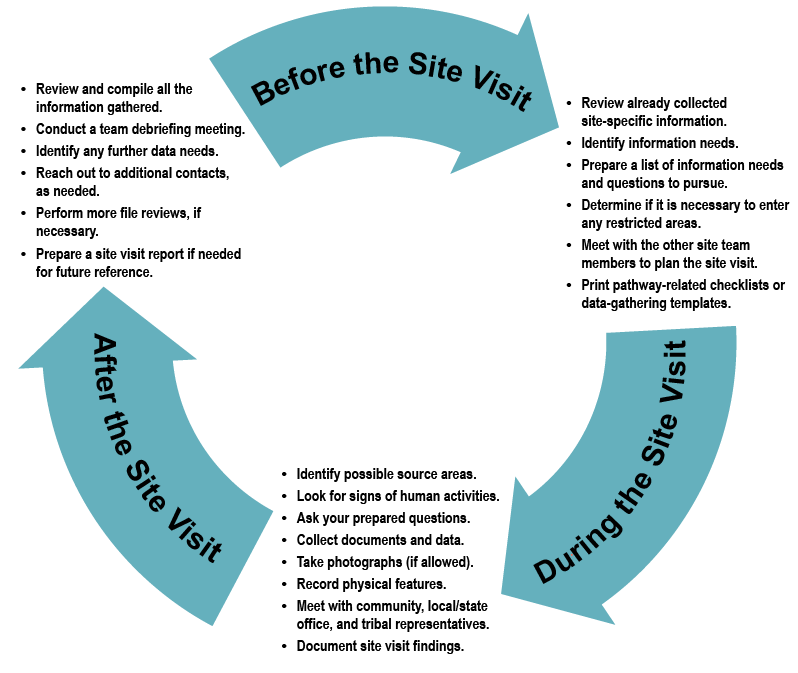
Work with Community Members and Other Stakeholders
ATSDR broadly defines the community associated with a site as the entire population living on and around the site. Community members and community-based organizations are excellent sources of information about the site and community health concerns, including:
- Site-specific issues.
- Nature of the concerns.
- Local behavioral patterns that may influence exposures.
- Degree to which the community is involved.
Tip: Conduct the site tour before meeting with the community so that you can better understand community references and locations they may mention.
Remember: Before reaching out to any community members directly, you need to have a firm understanding of ATSDR’s process for engaging the community . While initial contact with community members and others could happen during the site visit, working with stakeholders is a process that will likely continue throughout the PHA process.
Community Contacts
Working with the community engagement specialist, health educator, and regional representative, you can typically identify a few key community contacts (individuals and organizations) by reading through government site files or talking with staff from different government agencies. Some of the individuals and community groups that you might want to contact include:
- Individual site petitioners (if any) and local residents, particularly community leaders
- Site-specific advisory boards
- Tribal organizations/leaders
- Faith-based organizations
- Local medical society and other healthcare providers
- Fishing, hunting, agricultural, conservation, and industrial organizations
- Media outlets and social media influencers
- Community organizations
- Local community environmental groups
- Staff at universities or other area academic institutions
- School principals and school nurses
- Labor unions
- Staff of local institutions and facilities near the site (e.g., childcare centers, prisons)

- Reports are usually only 2-3 pages long, but in some cases, these reports may be much longer.
- In some cases, you may be asked to give recommendations or opinions about the site. In other cases, you will be asked only to describe the site.
- Ask your boss or instructor for models of other visit reports. If you can't get a model, look up samples online.

- If you visited a factory, explain what it is producing and what equipment it uses.
- If you visited a construction site, describe what is being constructed and how far along the construction is. You should also describe the terrain of the site and the layout.
- If you’re visiting a business, describe what the business does. State which department or part of the business you visited.
- If you’re visiting a school, identify which grades they teach. Note how many students attend the school. Name the teachers whose classes you observed.

- Who did you talk to? What did they tell you?
- What did you see at the site?
- What events took place? Did you attend a seminar, Q&A session, or interview?
- Did you see any demonstrations of equipment or techniques?

- For example, at a car factory, describe whether the cars are made by robots or humans. Describe each step of the assembly line.
- If you're visiting a business, talk about different departments within the business. Describe their corporate structure and identify what programs they use to conduct their business.
Reflecting on Your Visit

- Is there something you didn’t realize before that you learned while at the site?
- Who at the site provided helpful information?
- What was your favorite part of the visit and why?

- For example, you might state that the factory uses the latest technology but point out that employees need more training to work with the new equipment.
- If there was anything important left out of the visit, state what it was. For example, maybe you were hoping to see the main factory floor or to talk to the manager.

- Tailor your recommendations to the organization or institution that owns the site. What is practical and reasonable for them to do to improve their site?
- Be specific. Don’t just say they need to improve infrastructure. State what type of equipment they need or give advice on how to improve employee morale.
Formatting Your Report

- If you are following a certain style guideline, like APA or Chicago style, make sure to format the title page according to the rules of the handbook.

- Don’t just say “the visit was interesting” or “I was bored.” Be specific when describing what you learned or saw.

Sample Visit Report

Community Q&A
You Might Also Like

- ↑ http://services.unimelb.edu.au/__data/assets/pdf_file/0010/471286/Site_Reports_for_Engineers_Update_051112.pdf
- ↑ https://www.examples.com/business/visit-report.html
- ↑ https://www.thepensters.com/blog/industrial-visit-report-writing/
- ↑ https://eclass.aueb.gr/modules/document/file.php/ME342/Report%20Drafting.pdf
About This Article

To write a visit report, start by including a general introduction that tells your audience where and when you visited, who your contact was, and how you got there. Once you have the introduction written out, take 1 to 2 paragraphs to describe the purpose of the site you visited, including details like the size and layout. If you visited a business, talk about what the business does and describe any specific departments you went to. Then, summarize what happened during your visit in chronological order. Make sure to include people you met and what they told you. Toward the end of your report, reflect on your visit by identifying any strengths and weaknesses in how the site operates and provide any recommendations for improvement. For more help, including how to format your report, read on! Did this summary help you? Yes No
- Send fan mail to authors
Reader Success Stories
Betty Tarutia
Jul 9, 2020
Did this article help you?

Jayani Rathnayake
Aug 6, 2019
Jun 13, 2019
Atremedaki Phawa
Aug 19, 2019

Featured Articles

Trending Articles

Watch Articles

- Terms of Use
- Privacy Policy
- Do Not Sell or Share My Info
- Not Selling Info
Don’t miss out! Sign up for
wikiHow’s newsletter
25+ SAMPLE Construction Site Visit Report in MS Word
Construction site visit report in ms word, 25+ sample construction site visit report, definition:, a deep dive into on-ground realities:, understanding the purpose and significance of the report:, key components to include in the report:, effective practices for drafting a comprehensive report:, the impact of a well-constructed site visit report:, why is a site visit report crucial for construction management, how frequently should site visits and corresponding reports be conducted, can site visit reports help identify construction quality issues, what tools and technology can be used to generate site visit reports, how are equipment and material inventories documented in a site visit report, when reports assist in budget monitoring and financial planning.
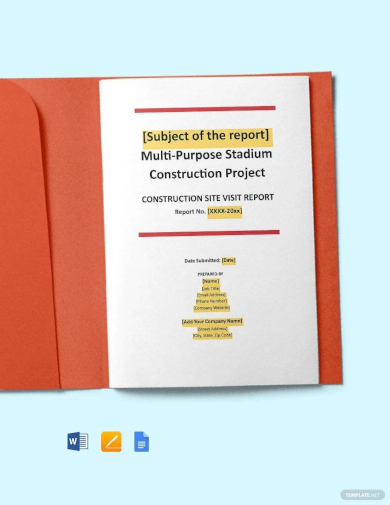
Construction Site Visit Report Template
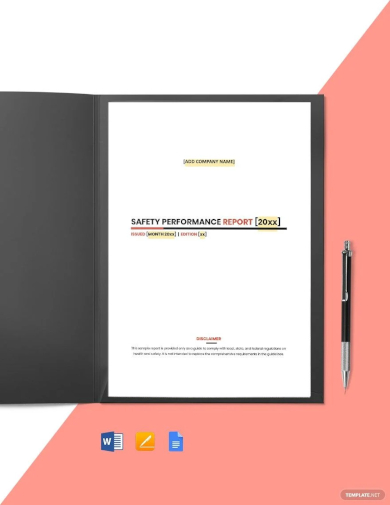
Construction Site Safety Report Template

Construction Site Incident Report Template
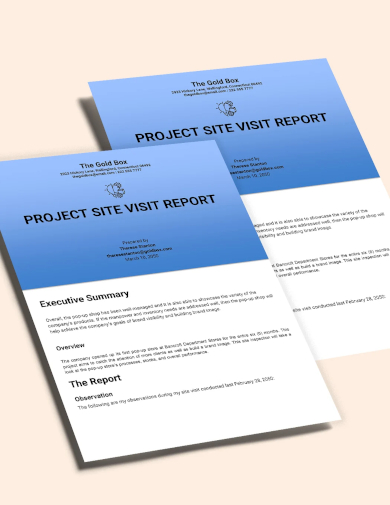
Project Site Visit Report Template
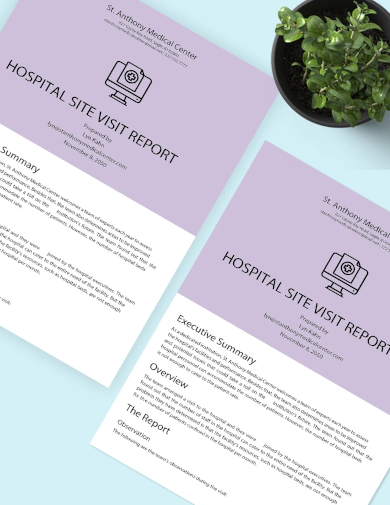
Hospital Site Visit Report Template
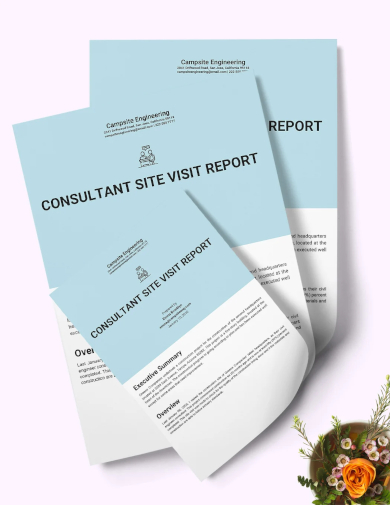
Consultation Site Visit Report Template
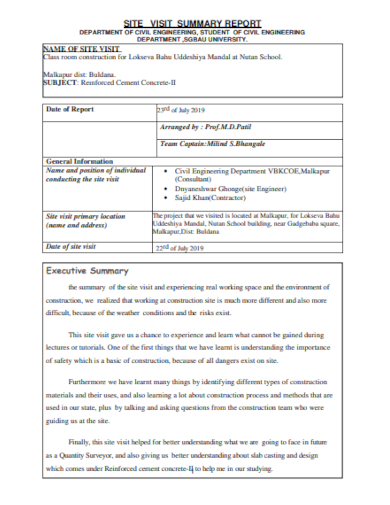
Construction Site Visit Summary Report
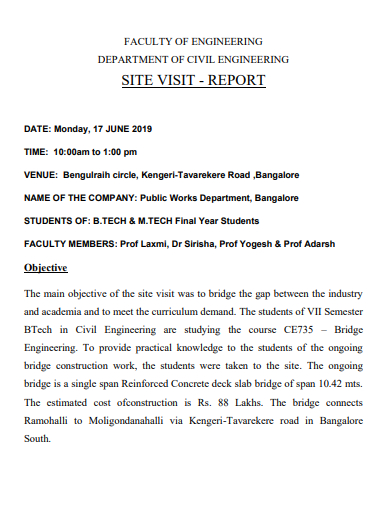
Construction Engineering Site Visit Report
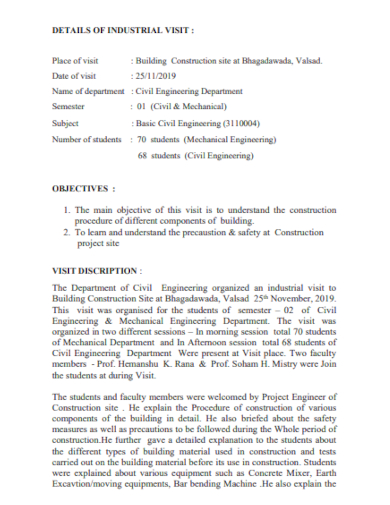
Construction Industrial Site Visit Report

Sample Construction Site Visit Report
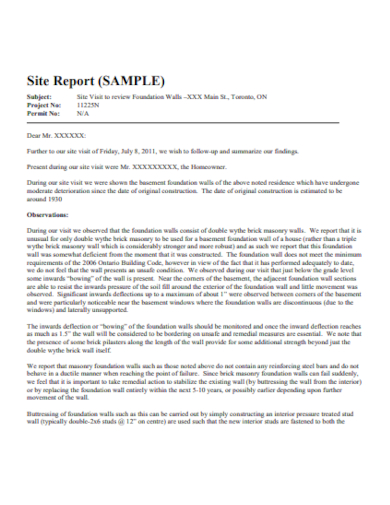
Construction Site Visit Report in PDF
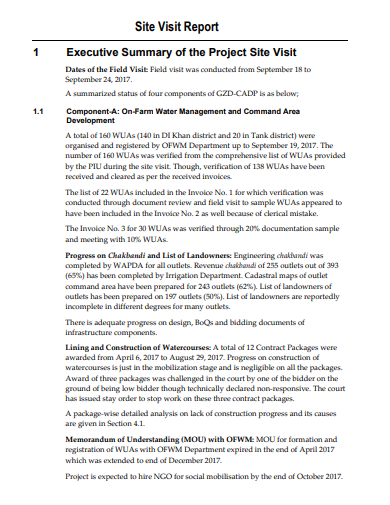
Construction Site Visit Executive Summary Report
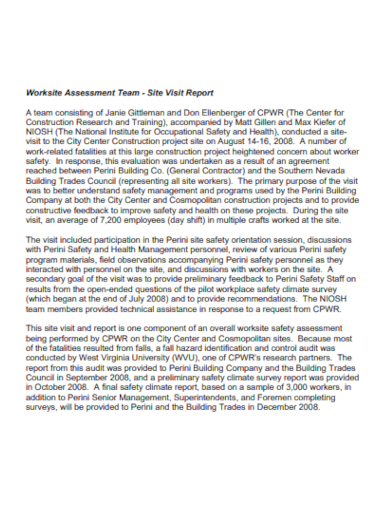
Construction Site Work Assessment Visit Report
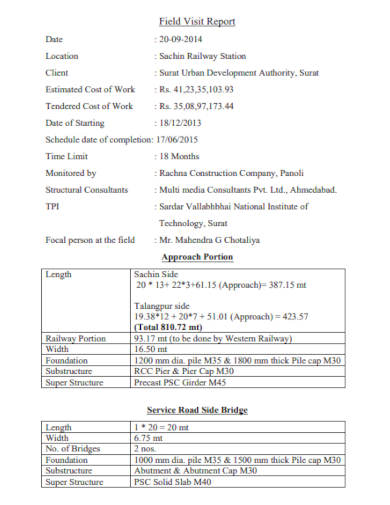
Construction Site Field Visit Report
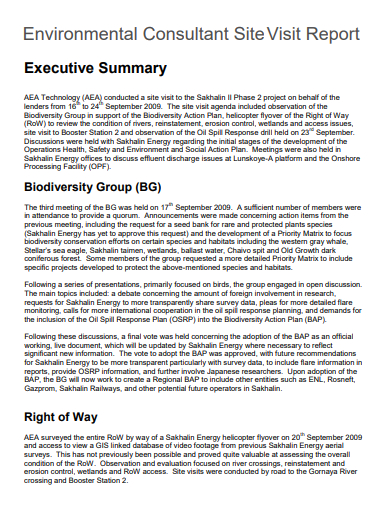
Construction Environmental Site Visit Report
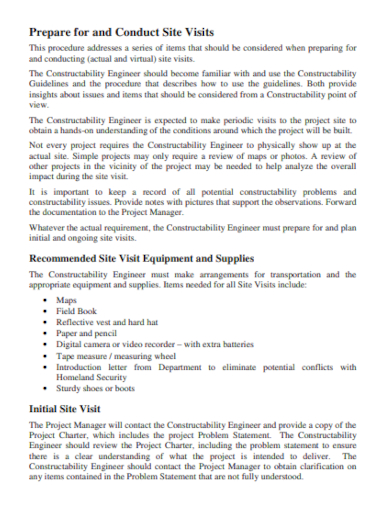
Construction Site Visit Report Format

Construction Site Visit Progress Report
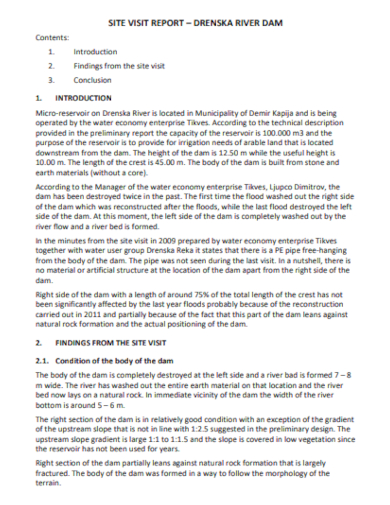
Bridge Construction Site Visit Report
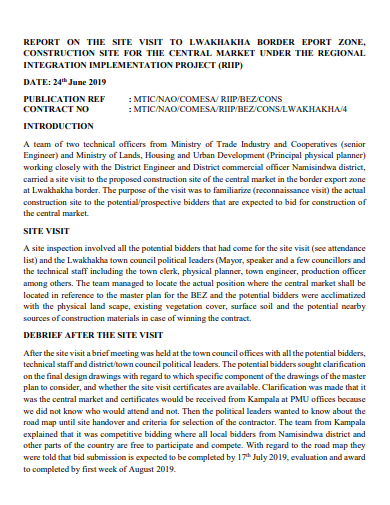
Road Construction Site Visit Report

Construction Project Site Visit Report
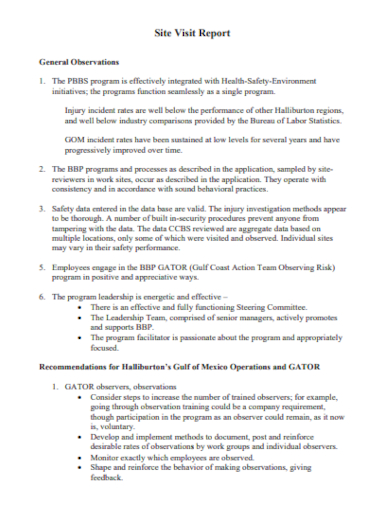
Construction Site Recommendation Visit Report

Civil Engineering Site Visit Report
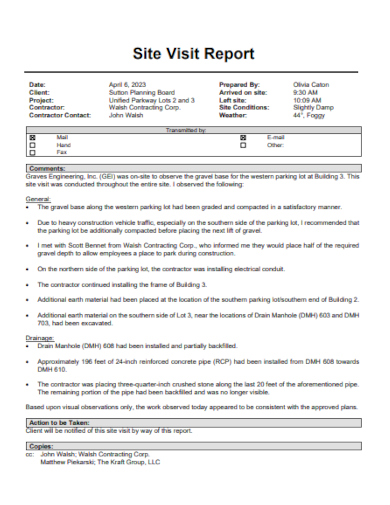
Building Construction Site Visit Report
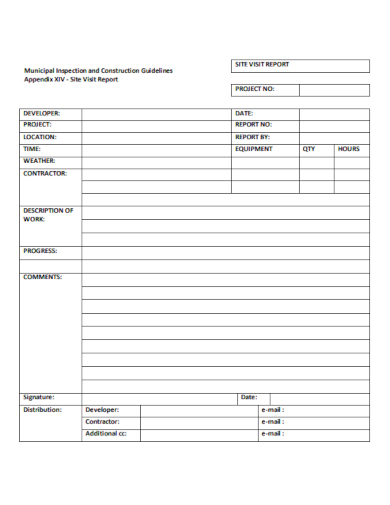
Construction Site Inspection Visit Report
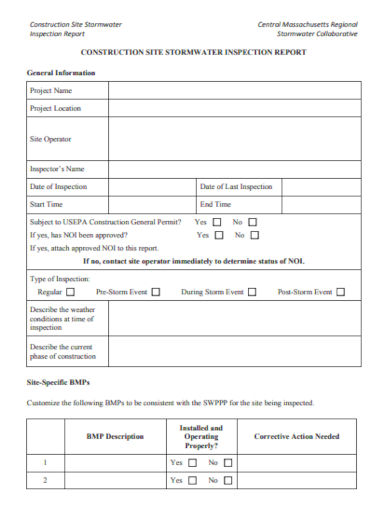
Construction Site Operator Visit Report

Report of Construction Site Visit
Purpose of the report:.
- Documentation: The report creates a recorded snapshot of the project’s status at a specific time, capturing details that can be referred back to if questions arise in the future.
- Communication: It serves as a structured communication tool, ensuring all relevant parties—be it site supervisors, project managers, stakeholders, or clients—are informed about the site’s present conditions and any observed issues.
- Quality Control: By highlighting discrepancies, deviations, or quality lapses, the report aids in maintaining the desired quality standards of the project.
- Safety Assurance: The report emphasizes safety protocols and identifies potential safety hazards, ensuring that workers’ safety remains a top priority and regulatory standards are met.
- Issue Identification and Resolution: Anomalies, bottlenecks, or concerns noted in the report can be promptly addressed, reducing potential downtime or project delays.
- Feedback and Recommendations: The report provides a platform for inspectors or visitors to offer feedback or suggestions, potentially improving project processes or outcomes.
Significance of the Report:
- Accountability: It fosters a sense of responsibility among the construction team, knowing that regular site visits will capture the real-time status and any deviations.
- Historical Record: Over time, these reports collectively serve as a history of the project’s evolution, documenting its journey from inception to completion.
- Stakeholder Confidence: Regular and transparent reporting assures stakeholders of the project’s direction and health, nurturing trust and confidence in the executing team.
- Risk Mitigation: By identifying and documenting risks early, the report aids in timely risk management, preventing potential financial or reputational damages.
- Benchmarking: The insights drawn from these reports can be used for performance benchmarking, measuring project progress against set standards or past projects.
Report Header:
- Project Name: The title or identifier of the construction project.
- Date of Visit: When the site inspection took place.
- Report Number: A unique identifier or sequence number for the report, especially if reports are frequent.
Visitor Details:
- Name: Who conducted the site visit.
- Title/Position: The visitor’s role or designation.
- Company/Affiliation: Which organization the visitor represents.
Site Details:
- Location: Address or description of the construction site.
- Project Manager/Supervisor: The person in charge on the site.
- Project Phase: Current stage of the construction project (e.g., foundation, framing, finishing).
Work Progress:
- Completed Tasks: Activities that have been finalized since the last report or visit.
- Ongoing Tasks: Current activities on-site.
- Planned Tasks: Upcoming work scheduled for the next period.
Safety Observations:
- Compliance: Noting adherence to safety protocols and standards.
- Incidents/Accidents: Any accidents or near-misses that have occurred.
- Safety Concerns: Potential hazards or unsafe practices observed.
Equipment and Material:
- Usage: A list of equipment and machinery in use.
- Condition: Noting any malfunctioning or damaged equipment.
- Material Stock: Observation of material inventory, highlighting shortages or surpluses.
Labor/Staff:
- Attendance: Number of workers present during the visit.
- Performance: General observations on work quality and efficiency.
- Training/Competence: Notes on any observed skill gaps or training needs.
Pre-Visit Preparation:
Standardized format:, active observations:, detailed and clear descriptions:, visual documentation:, avoid jargon:, be objective and neutral:, highlight critical issues:, confidentiality and access control:, review and proofread:, feedback and continuous improvement:, guided decision-making:, enhanced accountability:, safety assurance:, efficient resource management:, stakeholder confidence:, dispute prevention and resolution:, continuous improvement:, historical record and benchmarking:, share this post on your network, file formats, word templates, google docs templates, excel templates, powerpoint templates, google sheets templates, google slides templates, pdf templates, publisher templates, psd templates, indesign templates, illustrator templates, pages templates, keynote templates, numbers templates, outlook templates, you may also like these articles, 12+ sample construction daily report in ms word | pdf.
Introducing our comprehensive sample Construction Daily Report the cornerstone of effective project management in the construction industry. With this easy-to-use report, you'll gain valuable insights into daily activities report,…
25+ SAMPLE Food Safety Reports in PDF | MS Word

Proper food handling ensures that the food we intake is clean and safe. If not, then we expose ourselves to illnesses and food poisoning. Which is why a thorough…
browse by categories
- Questionnaire
- Description
- Reconciliation
- Certificate
- Spreadsheet
Information
- privacy policy
- Terms & Conditions
131 million in U.S. live in areas with unhealthy pollution levels, lung association finds
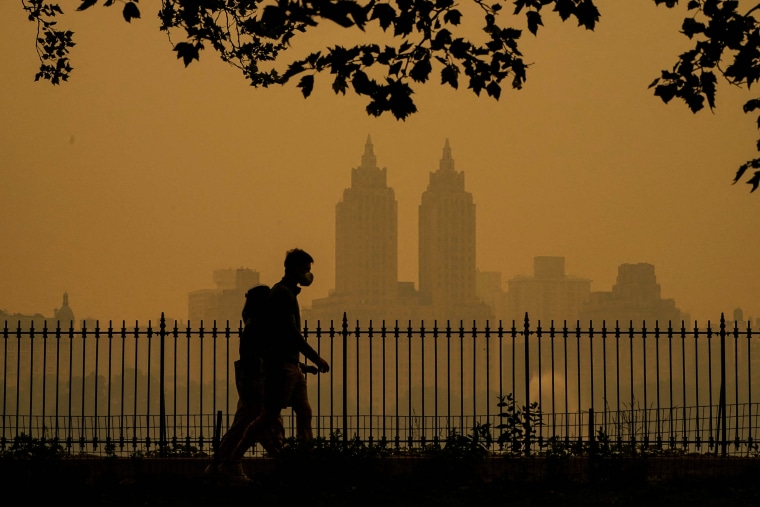
Nearly 40% of people in the U.S. are living in areas with unhealthy levels of air pollution and the country is backsliding on clean air progress as the effects of climate change intensify, according to a new report from the American Lung Association.
The organization’s report — its 25th annual analysis of the “State of the Air” in the country — found that between 2020 and 2022, 131 million people were living in areas with unhealthy levels of air pollution. The figure increased by nearly 12 million since the last survey a year ago.
The report also found that people in the United States experienced more “very unhealthy” or “hazardous” air quality days than any time in the survey’s history.
Katherine Pruitt, the national senior director for clean air policy at the American Lung Association, said climate change is chipping away at decades of cleanup efforts made through the Clean Air Act, a federal law passed in 1963 to regulate air pollution and set air quality standards.
“The changes happening in our climate and with heat and drought, and especially wildfire, have started to undo some of that progress we’ve made,” Pruitt said. “It is distressing to find that so many people are living with air quality that threatens their health.”
Wildfires are a fast-growing pollution source that policymakers are struggling to address. Climate scientists expect wildfire smoke to increase in the future, as greenhouse gas emissions push temperatures higher. The lung association’s analysis comes to the same conclusion as peer-reviewed research published last year in the journal Nature . Marshall Burke, an author of that study, suggested that wildfire smoke has undone about 25% of the Clean Air Act’s progress.
“If we take some steps back and tell what the root cause is, it’s the burning of fossil fuels,” said Dr. Lisa Patel, a clinical associate professor who practices as a pediatrician at Stanford Medicine Children’s Health. “We don’t need to be in this situation. We have the technology, we have the federal investment to get on renewables. What we need now is the political will.”
Every year, the “State of the Air” report analyzes air quality data of the three previous years. The analysis focuses on ozone exposure and on short-term and year-round exposures to particle pollution. The report issues grades for each measure and then summarizes how many areas pass or fail for each grade. Nearly 44 million people now live in areas that failed at all three criteria, according to the report.
Small particles are a significant concern because they can penetrate into people’s lungs, circulate in the bloodstream and affect other organs.
These particles, which are merely a fraction of the size of a human hair, have been shown to raise risk for asthma, lung cancer, chronic lung diseases, preterm birth and pregnancy loss.
Patel, who is also the executive director of the Medical Society Consortium on Climate and Health, said she has noticed an uptick in preterm births during periods of heavy wildfire events and has begun to counsel parents about how heat and smoke are a risk factor during pregnancy.
“When we have weeks of poor air quality, we see more pregnant individuals coming in and delivering before 37 weeks,” Patel said, adding that parents often question whether their actions could have contributed to an early birth. “When they ask about risks for premature birth, I do say climate change. Both heat and wildfires are a risk factor. They’re not in your control.”
Additionally, Patel said she has noticed that patients in her pediatric clinic often complain of nasal infections, eye irritation and asthmatic exacerbations, among other ailments, when wildfire smoke events happen in California.
Pruitt said particle pollution concerns once centered on the industrial Midwest and the Northeast. But in this report, for the first time, all 25 of the cities with the most daily particle pollution were in the West. Most were in California.
“Early in our history, a lot of particle pollution was coming from coal-fired power plants and transportation sources and industrial processes,” Pruitt said. “As the Clean Air Act has cleaned those sources up, particle pollution problems in the eastern U.S. have gotten much less serious. But in the West, they’ve of course had the same access to regulations and cleanups, but they are also being gobsmacked by climate change and wildfire.”
Daniel Mendoza, an assistant professor of atmospheric sciences at the University of Utah, said many communities in western states are dealing with acute, short-term pollution episodes rather than chronic exposures over a long period of time. Scientists are still trying to untangle how damaging wildfire episodes are in comparison to extended exposures from industrial sources.
“Not all bad air pollution is created equal,” Mendoza said.
Pollution from transportation and industrial sources could continue to decline if the Environmental Protection Agency is able to implement the more stringent standards it has proposed. The EPA proposed a rule last year that would require nearly all of the country’s coal and large gas plants to reduce or capture about 90% of their carbon dioxide emissions by 2038 .
This March, the agency implemented stricter rules to reduce tailpipe emissions from passenger vehicles . Another EPA policy, aimed at curbing nitrogen oxide pollution that travels across states , was challenged in the U.S. Supreme Court. In 2022, the Supreme Court limited the administration’s ability to use the Clean Air Act to reduce greenhouse gas emissions.
The report has one bright spot: Ozone pollution has continued its dramatic improvement. About 2.4 million fewer people are living in areas with unhealthy ozone pollution in comparison to last year.
Wildfire smoke has worsened in the time since this analysis was complete: Americans in 2023 breathed in more wildfire smoke than any other year on record, the Stanford researchers found last year.
Evan Bush is a science reporter for NBC News. He can be reached at [email protected].

IMAGES
VIDEO
COMMENTS
A site visit report is a comprehensive document that captures the details, observations, and the progress of a particular site at a specific point in time. This is often used by project managers, engineers, architects, and other professionals to document site conditions, progress, or any issues that might arise. ... Environmental considerations ...
A site visit analysis is a comprehensive report that summarizes the findings of a physical inspection of a potential development site. It includes information on the site's physical characteristics, location, surrounding area, demographic information, environmental impact, zoning regulations, traffic flow, and recommendations for development.
Site Visit: A qualified environmental professional visits the property to inspect for visual signs of contamination (e.g., stained soil, stressed vegetation, unusual odors). ... The changes from the 2013 to 2021 ASTM standards do not significantly alter the Phase I Environmental Site Assessment report or process, but there are a few key changes ...
performance and to ensure construction and environmental requirements, such as the Environmental Mitigation and Monitoring Plan (EMMP), are met. ... processes for site visit report submission and records management, and site visit report use and learning. 2. Expectations for conducting site visits should be found in the COR/AOR (or their designate)
A Phase I Environmental Site Assessment Checklist includes four main components with multiple pieces of information to be gathered for each one. 1. Records Review. A records review involves obtaining and reviewing records in an extensive background search of the property to assess its use and analyze past activities that could lead to ...
An Environmental Site Assessment can refer to either a Phase I Environmental Site Assessment (ESA or Report), a Phase II ESA or just the 'site visit' portion of a Phase I ESA. If you are looking for information on the entire process of a Phase I Environmental Report, click through the link to learn more.If you're here to understand just what is done in the site visit portion of a Phase I ...
1U.S. EPA grant recipients are required to report assessment activities through U.S. EPA's Assessment, Cleanup and Redevelopment Exchange System (ACRES). Between 40-65% of annual brownfield grants awarded are assessment grants. As of February 2020, Brownfield assessment grants have funded Phase I Environmental Site Assessments at 24,036 sites ...
There are three phases of environmental site assessments and Phase 1 is the introductory phase. It involves the identification of Recognized Environmental Conditions (RECs). REC means the presence or potential presence of hazardous substances or petroleum products in, on, or at the property as defined by ASTM. Phase I ESA is usually done before ...
Here's a breakdown of what should typically be integrated in a site visit report report: Project Reference: The construction project name and reference ID. Location: That precision address or co-ordinates of the construction site. Date of Site Visit: The specific date (s) when the visit is included. Prepared By: The name of the individual or ...
IDENTIFIES POTENTIAL OR EXISTING ENVIRONMENTAL CONTAMINATION LIABILITIES **Standards for a Phase I ESA Report have been updated from E1527-13. Please visit our service page for more information. A Phase I Environmental Site Assessment, commonly referred to as an ESA, or Phase I ESA, is completed to research the current and historical uses of a property as part of a commercial real estate ...
a site visit is required; and Completed EBRD's E&S site visit e-learn. Annex A provides more detail on each of the common E&S risks and issues outlined in this checklist. Disclaimer: Note that this guidance only covers a number of commonly found E&S risks and issues you may find during a site visit. This is not an exhaustive list of E&S risks ...
Phase 1 Environmental Site Assessments cost anywhere between $1,800 to $4,600. The cost is dependent upon property location, and the complexity of the site's history and uses. A Phase I environmental site assessment can confirm suspicions about whether or not a property has potential risks, but it acts as only a single layer of a complete ...
Record Review is the first step to any phase 1 environmental. It requires an extensive background search of the property to assess any past activities that could lead to contaminations. The first step is to determine what the subject site and its neighboring properties are used for. Along with that, analyzing if any past records are indicating ...
A site visit is essential for gathering relevant site information. It helps you to: Meet site representatives, local officials, tribal organizations, community members, and other stakeholders. Establish contacts to facilitate the collection of relevant information. Tour the site to determine activities and possible ways that community members ...
1. Add a title page to the beginning of your report. The title should be the name of the visit and site, such as "Visit to Airplane Factory" or "Corporate Headquarters Visit Report." Under the title, include your name, your institution, and the date of the visit. Do not put any other information on this page.
SITE VISIT REPORT EPA REGION 4 (AL, FL, MS) Bayou Chico Decontamination Area (Myric Street) in Pensacola, Florida ... of Environmental Protection (FDEP) on June 1, 2010, as a temporary decontamination site. The site is operated by ERM and operates about 12 hours a day. Berms have been set up for a
The Impact of a Well-Constructed Site Visit Report: A well-constructed site visit report can profoundly impact a construction project in various ways, ensuring that all stakeholders remain informed and that the project stays on track. The significance of a thoroughly crafted report can be understood through its multi-faceted impact:
Nearly 40% of people in the U.S. are living in areas with unhealthy levels of air pollution and the country is backsliding on clean air progress as the effects of climate change intensify ...